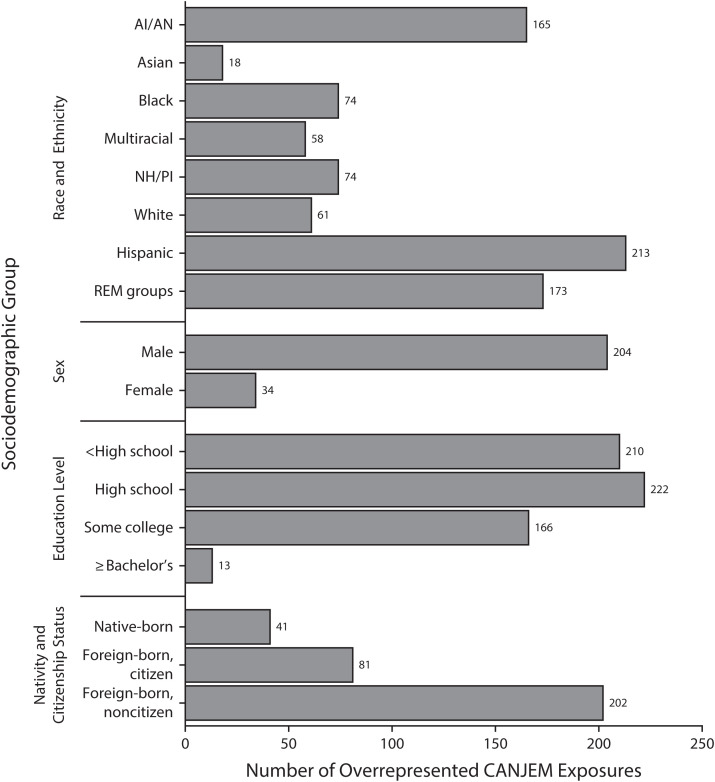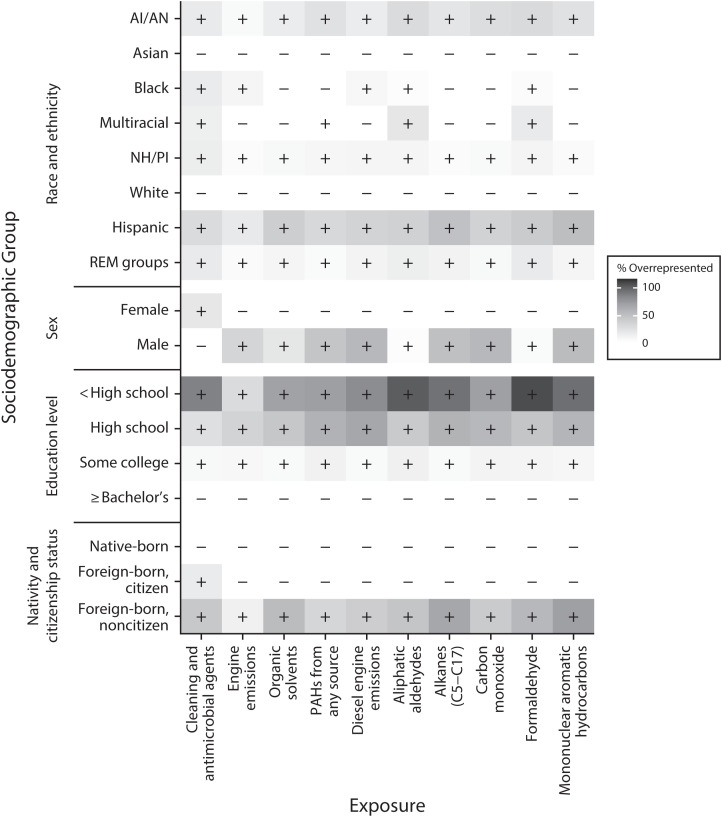In: Stephan-Recaido SC, Peckham TK, Lavoué Jerôme, Baker MG. Characterizing the burden of occupational chemical exposures by sociodemographic groups in the United States, 2021. Am J Public Health. 2024;114(1):57–67.
When originally published, the Figure and Table callouts were reported incorrectly. On p. 61, column 1, the first full paragraph should read:
Table 2 shows the estimated number and percentage of US workers exposed to the 10 most-prevalent chemical agents, stratified by sociodemographic group. Among all workers, the most-prevalent exposures were cleaning and antimicrobial agents (22.5 million US workers exposed; 14.7% of total workforce), engine emissions (19.5 million; 12.8%), organic solvents (18.5 million; 12.1%), polycyclic aromatic hydrocarbons (15.4 million; 10.1%), and diesel engine emissions (12.7 million; 8.3%). The prevalence of exposures varied across sociodemographic groups. Figure 1 shows the total number of exposures in which each sociodemographic group was disproportionately exposed. For both the 10 most prevalent agents and all agents combined, American Indian/Alaska Native, Hispanic/Latino, male, and foreign-born noncitizen workers; workers from REM groups as a whole; and workers with lower educational attainment were routinely overrepresented in exposure. Workers from other REM groups were estimated to experience disproportionate exposure to many of the 10 most-prevalent exposures, including Native Hawaiian/Pacific Islander (10 of 10), Black/African American (5 of 10), and multiracial (4 of 10) groups. Figure 2 shows the magnitude of overrepresentation of exposure to the 10 most-prevalent agents by sociodemographic group. Workers with lower educational attainment generally experienced increasingly greater magnitudes of disproportionate exposure, and Hispanic workers experienced the greatest magnitude of disproportionate exposure among all racial and ethnic groups.
The figures appeared out of order. On p. 61, Figure 1 should be:
FIGURE 1—
Total Number of Overrepresented Chemical CANJEM Exposures by Sociodemographic Group in the United States, 2021
Note. AI/AN = American Indian/Alaska Native; Black = Black/African American; CANJEM = Canadian job-exposure matrix; Hispanic = Hispanic/Latino; NH/PI = Native Hawaiian/Pacific Islander; REM groups = racial and ethnic minoritized groups; some college = some college or associate degree; White = non-Hispanic White. Persons within each race category are of any ethnicity, except for persons who identify as non-Hispanic White, and persons of Hispanic/Latino ethnicity are also counted in their preferred race category. REM groups include persons identifying as American Indian/Alaska Native, Asian, Black/African American, multiracial, Native Hawaiian/Pacific Islander, or Hispanic/Latino.
On p. 62, Figure 2 should be:
FIGURE 2—
Magnitude of US Workers by Sociodemographic Group Overrepresented in Exposure to the 10 Most Prevalent Chemical Agents in CANJEM, 2021
Note. AI/AN = American Indian/Alaska Native; Black = Black/African American; CANJEM = Canadian job-exposure matrix; Hispanic = Hispanic/Latino; NH/PI = Native Hawaiian/Pacific Islander; PAHs = polycyclic aromatic hydrocarbons; REM groups = racial and ethnic minoritized groups; White = non-Hispanic White. A positive sign indicates overrepresentation of exposure (i.e., the number of workers exposed is in excess of the expected exposed based on the group’s share of the total workforce). Darker shades of gray indicate higher percentages of overrepresentation. A negative sign indicates underrepresentation of exposure (i.e., the number of workers exposed is under the expected exposed based on the group’s share of the total workforce). Persons within each race category are of any ethnicity, except for persons who identify as non-Hispanic White, and persons of Hispanic/Latino ethnicity are also counted in their preferred race category. REM groups include persons identifying as AI/AN, Asian, Black/African American, multiracial, Native Hawaiian/Pacific Islander, or Hispanic/Latino.
The article’s full citation was listed incorrectly. On p. 66, the citation under the Publication Information section should read:
“Stephan-Recaido SC, Peckham TK, Lavoué J, Baker MG. Characterizing the burden of occupational chemical exposures by sociodemographic groups in the United States, 2021. Am J Public Health. 2024;114(1):57–67.”
These changes do not affect the article’s conclusions.




